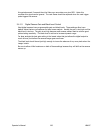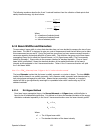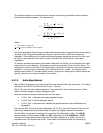6.3 Beam Presentation Affects Results
Effective beam presentation is essentially an attempt to improve accuracy by increasing the signal-to-
noise property of the digitized data. Since the camera and the digitizing process primarily fix the noise
level, most of our efforts will concentrate on increasing the signal content.
Always try to optimize your beam's amplitude into the camera's dynamic operating range. Whenever
possible, use external optical attenuation or a camera with electronic shutters to bring the beam's peak
signal levels into the upper half of the video signal's dynamic range. If optical attenuation leaves you
with low signal amplitude, you can use the LBA's video gain control to restore some of the loss.
Note: Increasing gain also increases noise, so use it sparingly. Changing the gain setting also affects the Black
Level, so set the gain level first, and then use Ultracal! to readjust the Black Level and calibrate to the new noise
conditions.
Always use the highest possible hardware zoom magnification level that will contain all of the beam's
energy.
If your beam intensity is low and/or covers only a small fraction of the display window, use an aperture
to eliminate the background energy noise in the wings.
Use external optical magnification if your beam begins to approach only a few pixels in width. It takes
at least 10 pixels to get a reasonably good beam width measurement.
6.4 Manual Background Energy Nulling
Manual Background Energy Nulling is NOT recommended. Use the Ultracal! calibration feature instead.
Do not place any confidence in the computed results until you have nulled the background energy levels
using Ultracal!.
The LBA-PC provides three different methods to assist you in removal of unwanted background energy
from the quantitative calculations. They are:
• Ultracal! processing.
• A Drawn Aperture that can be drawn around the energy of interest, isolating the beam and
effectively forcing all the energy outside the aperture to zero.
• An Auto Aperture feature that will draw an optimally sized aperture around your beam energy.
6.4.1 What is Ultracal!
The Ultracal processing feature should be used instead of manual energy nulling techniques. Ultracal
employs a sophisticated proprietary algorithm that will yield greatly improved accuracy over various
operating conditions and signal dynamic range. In addition, it can quickly be rerun if changes in
setups are required as experimental conditions are modified.
Before executing Ultracal! be sure to optimize your beam presentation. This is essential as the
Ultracal cycle will be specific to the current Pan/Zoom and Video Gain settings. You may also place a
manually drawn aperture at this time, or later if you wish. The aperture is not locked by the
calibration cycle and may be manipulated by the operator at any time.
The Ultracal! cycle can be run at any time, either in 2D or 3D mode. You must have the laser beam
blocked from the camera detector. After completion of the Ultracal! cycle, the results will be
accurate as long as the setup conditions remain the same, and your camera black level, shading and
noise conditions do not change. Since most cameras tend to be a little drifty, we recommend that you
Operator’s Manual LBA-PC
Doc. No. 10654-001, Rev 4.10
129


















